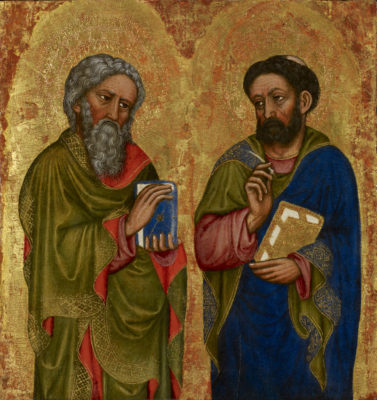ZANINO DI PIETRO
(active in Venice, Bologna and the Marche from 1389 to 1448)
Two evangelists.
Circa 1410-1420.
Tempera on panel, gold ground
18 x 17 in. (45,7 x 42,8 cm).
Provenance :
Switzerland, private collection (in 1961).
France, private collection.
Bibliography :
. F. Zeri, Aggiunte a Zanino di Pietro, in « Paragone », september 1962, XIII, n° 153, fig. 54.
. F. Zeri, « Aggiunte a Zanino di Pietro », in Giorno per giorno nella pittura. Scritti sull’arte dell’Italia settentrionale dal Trecento al primo Cinquecento, Torino, Umberto Allemandi, 1988, pp. 15-17 and fig. 11.
. F. Zeri, « Du nouveau sur Zanino di Pietro », in La peinture au fil des jours du XIVème au XVIème siècle, 1990, p. 16, fig. 11.
This painting, as Federico Zeri noted some fifty years ago, originally formed one of the laterals of a small altarpiece, the other being a similarly-composed Saint Dominic and another Saint (fig. 1; auctioned at Paris Drouot, Thierry de Maigret, 4 December 2009, lot 7); both panels have been reduced in height.
Roberto Longhi (Viatico per cinque secoli di pittura veneziana, Florence, 1946, p. 49) was the first to assemble the rare oeuvre of this highly original painter, to which some new pieces have since been added. Notable works include the polyptych in the Franciscan convent of Sassoferrato, near Mombaroccio (Province of Pesaro), the triptych in the Diocesan Museum in Camerino (from the church of Valcarecce, near Cingoli), the Crucifixion in the Pinacoteca in Rieti (signed and dated 1402), a Crucifixion formerly in the Chillingworth collection and the Flagellation in the Museo Correr in Venice. Zanino also decorated the façade of the Ca’ d’Oro in Venice.
In 1985 Serena Padovani (« Una nuova proposta per Zanino di Pietro », Paragone, XXXVI, pp. 73-81) proposed that Zanino was in fact Jean Charlier, called Giovanni di Pietro di Francia, the author of a Virgin and Child, signed and dated 1429, and housed in the Palazzo Venezia, Rome. This opinion was shared by M. Boskovits (1985) and Mauro Lucco (« Venezia 1400- 1430 », in La pittura nel Veneto, Il Quattrocento, Milan, 1989, I, p. 21f. and p. 363). Zanino’s sojourn in Bologna between 1389 and 1403, where he was close to Simone dei Crocefissi and Lippo di Dalmasio, was followed by a move to Venice, where he remained until at least 1437.
Zanino di Pietro became one of the most interesting painters in the first quarter of the fifteenth century in Venice, together with Nicolò di Pietro and Jacobello del Fiore. Influenced by Gentile da Fabriano and Michelino di Besozzo, his work also shows parallels with the Cologne School of the early fifteenth century. Our two Evangelists are striking for their very expressive faces – matched by those of the ascetic Saint Dominic and his preoccupied holy companion in the other panel – a feature that might have its origin in the artist’s Bolognese period.
A number of characteristic elements found in this panel – sinuous draperies, rhythmic fall of folds, play of colours in the linings, expressive faces and a vivid chromatic range, dominated by reds, blues and brilliant greens – provide clear evidence for dating it to the period of the International Gothic, that is, around the years 1410-1420. An artist whose language was truly individual, sometimes even disconcerting in its eccentricity, Zanino di Pietro was also a catalyst for the spread of this style to the coast of Dalmatia and the Marches.
